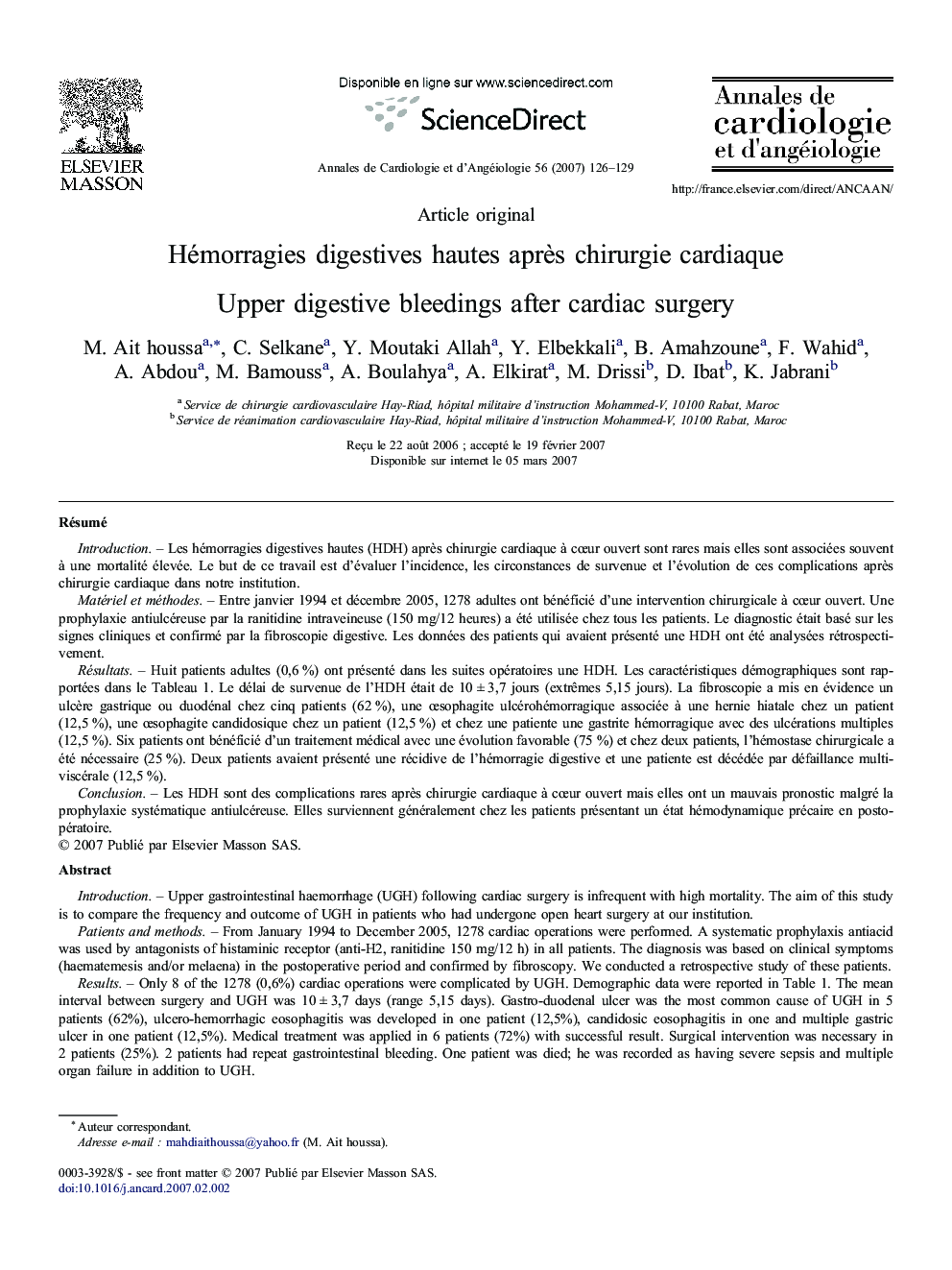| Article ID | Journal | Published Year | Pages | File Type |
|---|---|---|---|---|
| 2869341 | Annales de Cardiologie et d'Angéiologie | 2007 | 4 Pages |
RésuméIntroductionLes hémorragies digestives hautes (HDH) après chirurgie cardiaque à cœur ouvert sont rares mais elles sont associées souvent à une mortalité élevée. Le but de ce travail est d'évaluer l'incidence, les circonstances de survenue et l'évolution de ces complications après chirurgie cardiaque dans notre institution.Matériel et méthodesEntre janvier 1994 et décembre 2005, 1278 adultes ont bénéficié d'une intervention chirurgicale à cœur ouvert. Une prophylaxie antiulcéreuse par la ranitidine intraveineuse (150 mg/12 heures) a été utilisée chez tous les patients. Le diagnostic était basé sur les signes cliniques et confirmé par la fibroscopie digestive. Les données des patients qui avaient présenté une HDH ont été analysées rétrospectivement.RésultatsHuit patients adultes (0,6 %) ont présenté dans les suites opératoires une HDH. Les caractéristiques démographiques sont rapportées dans le Tableau 1. Le délai de survenue de l'HDH était de 10 ± 3,7 jours (extrêmes 5,15 jours). La fibroscopie a mis en évidence un ulcère gastrique ou duodénal chez cinq patients (62 %), une œsophagite ulcérohémorragique associée à une hernie hiatale chez un patient (12,5 %), une œsophagite candidosique chez un patient (12,5 %) et chez une patiente une gastrite hémorragique avec des ulcérations multiples (12,5 %). Six patients ont bénéficié d'un traitement médical avec une évolution favorable (75 %) et chez deux patients, l'hémostase chirurgicale a été nécessaire (25 %). Deux patients avaient présenté une récidive de l'hémorragie digestive et une patiente est décédée par défaillance multiviscérale (12,5 %).ConclusionLes HDH sont des complications rares après chirurgie cardiaque à cœur ouvert mais elles ont un mauvais pronostic malgré la prophylaxie systématique antiulcéreuse. Elles surviennent généralement chez les patients présentant un état hémodynamique précaire en postopératoire.
IntroductionUpper gastrointestinal haemorrhage (UGH) following cardiac surgery is infrequent with high mortality. The aim of this study is to compare the frequency and outcome of UGH in patients who had undergone open heart surgery at our institution.Patients and methodsFrom January 1994 to December 2005, 1278 cardiac operations were performed. A systematic prophylaxis antiacid was used by antagonists of histaminic receptor (anti-H2, ranitidine 150 mg/12 h) in all patients. The diagnosis was based on clinical symptoms (haematemesis and/or melaena) in the postoperative period and confirmed by fibroscopy. We conducted a retrospective study of these patients.ResultsOnly 8 of the 1278 (0,6%) cardiac operations were complicated by UGH. Demographic data were reported in Table 1. The mean interval between surgery and UGH was 10 ± 3,7 days (range 5,15 days). Gastro-duodenal ulcer was the most common cause of UGH in 5 patients (62%), ulcero-hemorrhagic eosophagitis was developed in one patient (12,5%), candidosic eosophagitis in one and multiple gastric ulcer in one patient (12,5%). Medical treatment was applied in 6 patients (72%) with successful result. Surgical intervention was necessary in 2 patients (25%). 2 patients had repeat gastrointestinal bleeding. One patient was died; he was recorded as having severe sepsis and multiple organ failure in addition to UGH.ConclusionUGH in patients undergoing heart operation is rare but associated with poor prognosis despite antiacid prophylaxis. These complications occurred in patients who had in postoperative bad hemodynamic conditions.
